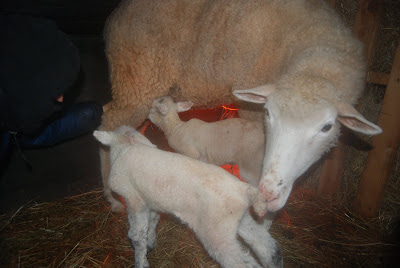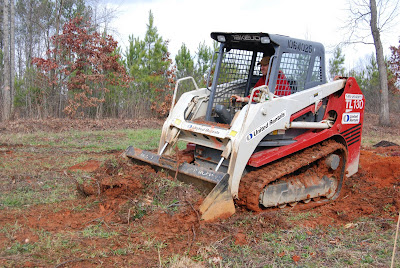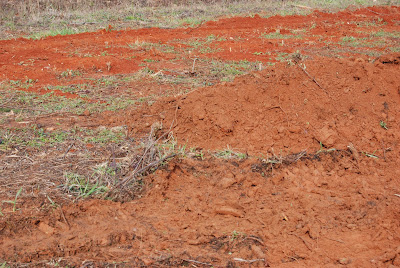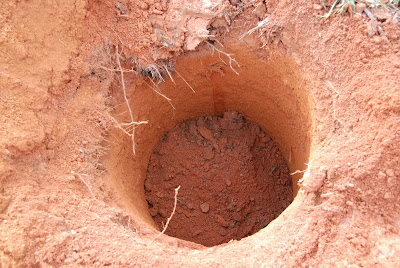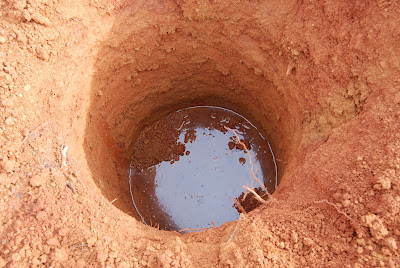Phil finished drilling the second row of trees this morning early. Jadon and I helped him layout the next seven rows or so, stringing baling twine attached to T-posts at precise intervals. Then Phil scraped the topsoil off several of those rows.
Sheep Ashley continues to appear more ready to deliver a lamb. Her bag appeared to me to be more full (even sticking out behind her legs a bit). In one of the reference books I frantically read yesterday, the author suggested that feeding grain at midday could force a daytime birth, so at midday I brought her some (organic) cracked corn. She ate with good will; I had a difficult time keeping the goats away from her as she consumed the first several cups of grain I’ve fed her.
Towards dusk, Phil left for Scottsville to get some straw bales, just in case Ashley went into labor. We wanted to make a “jug,” like a maternity room for women, where an ewe and her newly born lambs can rest, get acquainted, and begin life well. Phil had already put up some pallets with a tin roof on the backside of the chicken coop, so we just stacked strawbales three high all the way around the outside, leaving a little walkway in the center.
When Phil had left, snow had just begun to fall. By the time he returned, it was a few inches thick, and coming fast. As near as we could tell, Ashley was not in active labor (what does a sheep contraction look like, anyway? How would I know?). She was holding her tale out, almost like a duck, a sign that means “labor in two to three days.” This was very reassuring; I prayed that her babies would not come tonight, in the dark, in the snow.
After the boys went to bed, we were discussing which trees to keep, and which to get rid of. We don’t think all the trees will fit in the clearing, so are there some that are more vital than others? And, with the snow, we think we’ll send back the skid steer on Monday; we’re supposed to have snow cover for quite some time.
Phil had a sudden craving for cookies. Dear Berenice, an older woman from our Bible study, had brought beautiful decorated Christmas cookies (with wheat) for the five children. We had left them in the truck yesterday, as we tried to get all the sleeping children in the house after study, so Phil suited up to claim his prize (as he is the only one who eats wheat, he decided he could make the sacrifice). He left me typing this; I had got as far as “She ate with good will” when he opened the door, said, “Your prayers weren’t answered. Ashley delivered her twins. Get suited up.”
What an adrenaline rush! I tromped through 12 inches of snow, audibly praising the Lord that He was providing for these precious babies. Praising the Lord that Ashley is not a first time mom, that she delivered without incident, that Phil had a cookie craving.
We think we reached the lambs within minutes of their births. All the other sheep were crowded around; the three babydoll lambs watching (two learning what will happen to them in 2011). Phil and I each picked up a baby and carried them, at ground level, to the jug (thank the Lord we had prepared it before nightfall!). Then I became the task master and Phil the ready servant. Since I had read the books, I knew what to do.
First: towels for the babies. They were severely chilled. The firstborn, a ram lamb had actually frozen stiff in the few minutes outside; the second born, an ewe lamb, was not yet breathing, because the sac was covering her mouth and nose, and she, too, was extremely cold. I cleaned out her nose and mouth until she made little noises. When Phil brought blankets, I started to dry them off.
Thankfully, they were shivering. If they weren’t, that would have been a sign that they were too chilled, and we would have had to take drastic measures (ideally, submersion in warm water followed by a hair dryer; this would have been nigh impossible, as we have no running warm water and own no hair dryer). I also cut a bit off their umbilical cords and soaked their cords in iodine. All we had was 2% iodine solution which Phil picked up on his way home today; we are supposed to use 7% solution. I pray that, in this instance, the Lord will be gracious and protect those lambs from anything bad getting into their umbilical cords and causing an infection.
The lambs would not stop shaking. We put up a heat lamp (removed from the chickens—sorry, biddies!); Phil got a cattle panel and put it in front of the door, after we shooed out the four other interested sheep. (When I had first entered the jug with the babies, there was me, and seven snow covered animals in a pretty small space. I am not terribly claustrophobic, but it was a relief to get the others out!) I checked inside their mouths to see if their mouths were cold; thankfully, they never were, as I was concerned enough without negative indications.
I did my best to thoroughly dry the lambs off; their wool is dense, though, and it was not easy. Ashley is a mothering pro: she licked them and nickered to them (it almost sounded like a warning grunt directed to me, but I think it was loving to them). Phil brought her warmed water (what a treat!) with molasses in it, and fresh hay for them to lie on and for her to eat.
The other task I needed to do as sheep midwife was to strip her teats. The sheep get a wax plug that can freeze up in cold weather, so a person needs to strip it out. I almost thought it was impossible, so I’m thankful I didn’t make the lambs try to do it. I milked out just a little colostrum for future use, but Ashley wasn’t thrilled with my attempts, so I didn’t get nearly as much as I wanted. (Colostrum is important to have on hand in case an ewe dies in birth at some future date; lambs MUST have colostrum, because, unlike humans, they get no antibodies from their mothers in utero. Human babies get some through the umbilical cord and some through colostrum, but sheep get it all through colostrum. Thus, it is an absolute necessity.)
Having read many books about the necessity of colostrum, preferably in the first half hour, I was pretty concerned. I figured, though, that the Lord has been guiding us so graciously thus far, he wouldn’t stop now. After all, yesterday morning I thought, out of the blue, “I should go look at the sheep.” Which seemed like a frivolous and almost wasteful thing to do—I have five children to take care of, and now I want to frolic with sheep in the middle of the day? But the impression was so strong, I went, and that was when I noticed the enlarged udder and then the “dropped” appearance made sense.
Anyway, at Phil’s urging, I took a break from the sheep and lambs and went inside. It was now 11:30pm, and I read a few more tidbits that persuaded me to go out and try again to get the babies to eat. I milked more colostrum, and fed it, finger by finger, to the babies. Soon after this, they began baaing more lustily (yay!) and the ram stood up! Yippee! From frozen to standing in such a short time! He was pretty clueless about finding the udder, and I felt bad because ideally the ewe would be shorn before lambing (this is really not a seasonal birth, and there was no way I wanted to shear Ashley right at the start of winter). The baby kept trying to suck the dirty, wet wool, but Ashley was patient and directed him to where he needed to go. He drank noisily and happily a few times.
By then his sister was standing, but Ashley didn’t try to direct her. Ashley does lick her, so she has accepted the baby, but she didn’t give any of the helpful nudges or whickerings that she offered the ram lamb. Phil had joined me in the jug then, so we tried together to get the ewe lamb to drink. She does not appear to be the sharpest tool in the shed, but by physically putting the teat to her mouth, she, too, drank well.
Ashley passed the afterbirth without any trouble and so, at 1am, our task was done. The Lord was very gracious to us raw beginners on this raw night; the 12 inches or more of snow we have now would have left no lambs alive by morning, had Phil not had a hankering for Christmas cookies.





